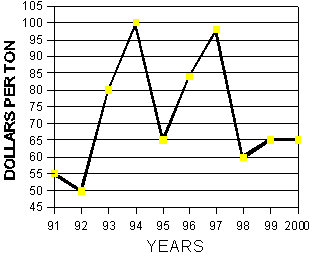Alfalfa Report
Yuma County, Arizona
August 28, 2000
Yuma County Office
2200 W. 28th Street, Ste. 102
Yuma, AZ 85364
(520) 726-3904
(520) 726-8472 FAX
Production Update:
PDF version, KB
Planting Date: October is the optimum planting date for low desert areas in Arizona, although it is possible to plant alfalfa from September through March. Crop establishment is best in October plantings. Planting too early can result in poor crop establishment due to hot weather, losses from competition from summer weeds, or damage from feeding from whitefly. Winter plantings are at risk for freeze damage, and seedlings with one trifoliate leaf stand a better chance of surviving freeze damage than younger seedlings. Hay production during the first spring is missed in spring plantings and production is delayed until the first summer. Spring plantings tend to be subject to more weed competition and result in a less developed root system compared to fall planting during the establishment year. Delaying planting past October can decrease yields for the life of the stand.
Insect Management: Empoasoa spp. leafhopper occasionally cause economic damage in low desert alfalfa. These tiny yellowish-green insects cause a characteristic wedge-shaped yellow area on the outer end of leaflets. The leafhoppers inject salivary toxins that cause the yellowing and stunting. The yellowing can spread over the entire plant, giving the field a yellowish appearance. Adult leafhoppers migrate to alfalfa from vegetable fields and weeds. If damaging infestations are not controlled, toxin levels in the crown may persist to stunt and yellow subsequent cuttings. The treatment threshold is 5 to 10 leafhoppers per sweep. Treatments should be applied if counts reach 5 leafhoppers per sweep if alfalfa is 2 or more weeks away from harvest. Alfalfa scheduled to be harvested in 10 days to 2 weeks should be treated if counts reach 10 per sweep. Treat only the field edges where high leafhopper counts of a treatable magnitude are confined to the first 50 to 100 feet of the field margin.
Weed Control: Red sprangletop has become increasingly widespread
along the entire Colorado River. This is probably the result of mild winters
which have allowed it to survive and the use of herbicides which have
controlled many other grasses but not sprangletop. Trifluralin is ineffective
on established plants and Poast and Select are weak in controlling this
weed.
| Market Summary |
High
|
Low
|
Average
|
Off grade
|
| Past 2 Weeks (August 14-28, 2000) |
70
|
60
|
65
|
50-60
|
| Last Year (August 14-28, 1999) |
70
|
60
|
65
|
50-60
|
10 Year Summary (August 14-28, 1991-2000):

Issued in furtherance of Cooperative Extension work, acts of May 8 and June 30, 1914, in cooperation with the U.S. Department of Agriculture, James A. Christenson, Director Cooperative Extension, College of Agriculture and Life Sciences, The University of Arizona.
The University of Arizona is an equal opportunity, affirmative action institution. The University does not discriminate on the basis of race, color, religion, sex, national origin, age, disability, veteran status, or sexual orientation in its programs and activities.
Any products, services, or organizations that are
mentioned, shown, or indirectly implied in this web document do not imply
endorsement by The University of Arizona.
Information provided by:
Barry Tickes, btickes@ag.arizona.edu Extension Agent, Yuma County
Michael Ottman, mottman@ag.arizona.edu Agronomy Specialist
College of Agriculture, The University of Arizona.
Eric Natwick, etnatwick@ucdavis.edu UCCE Imperial County - Farm Advisor
University of California, Davis, CA.
Material written August 28, 2000.
Forages: Crop Mgmt | Soil Mgmt | Irrigation | Alfalfa Reports | Insects | Diseases | Weeds | Pesticides
Home | Other Crops | Forages
For more Arizona Production Ag Information:
Home | Cotton | Veggies| Forages | Grains | Citrus | Crop x Crop | Insects | Diseases| Weeds | Pesticides | News | Weather | Research | Photos | Contacts | General Info. | Site Map
Copyright © 2001 University of Arizona,
College of Agriculture and Life Sciences
Webmaster: Al Fournier (fournier@ag.arizona.edu)